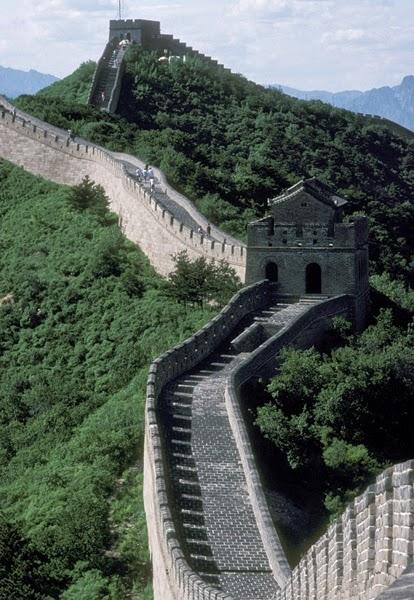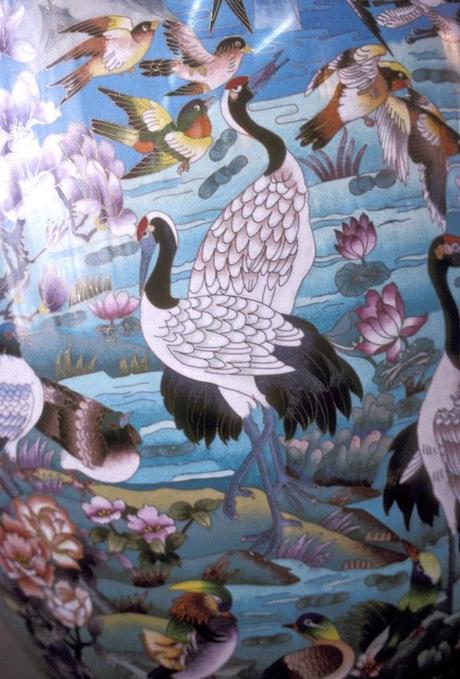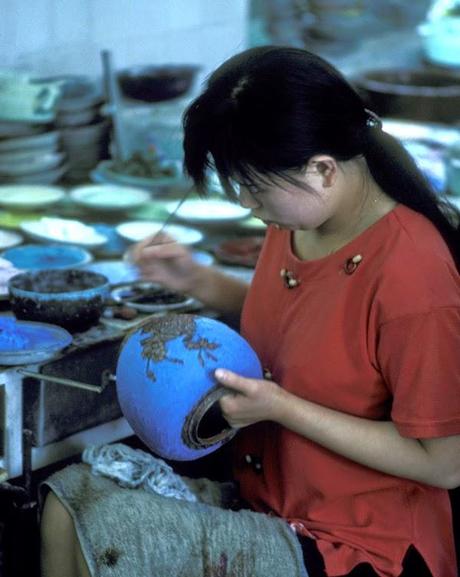
Great Wall of China, Badaling
The following is an excerpt from the diary of our trip to China July, 1995. We were traveling with three friends, spending five days in Beijing and then three days in Xian. China has changed greatly since our visit but many of the places we went to are still among the popular tourist spots.
Detail of Cloisonne Vase
Day 2: On our first full day in Beijing, after breakfast at our hotel, we climbed into our van for a trip outside the city. We drove northwest along wide streets and onto an expressway. Our first stop was a cloisonne factory where we watched people making each step of the process–forming the patterns by gluing bent strips of copper onto the posts, applying the color paste, firing the pots and grinding and polishing them at the end.

"Painting" the cloisonne designs
Our guide, Amy, revealed that the workers we saw were only representative and that the real factory was somewhere else. Flying over the yard were hundreds of swallows, by far the most common bird we saw in China. After buying souvenirs I went to the bathroom–my first experience with a half-door floor toilet.

Taking the cloisonne pots out of the kiln
Next stop was the Ming Tombs. We climbed up to the top of a hill and then descended a long stairway into the tombs–a series of underground rooms empty except for a few huge stone chairs. The locks on the doors were large versions of the anti-burglar poles that you jam into your door from the floor. After the tombs were built they were buried to create a large hill. Apparently all the workers were killed and buried in them so that no one except the next in line to the throne knew the location of the tombs. (The ancient Chinese seemed to have no compunction about rearranging the landscape to their liking–moving rocks hundreds of miles to create gardens, digging lakes, and using the earth to build small mountains.)
We left the Ming Tombs and drove through the countryside and a small town, and then began to wind our way up into the mountains past small houses made of brick or stone, each with a fenced in courtyard in front. We passed several sections of the Great Wall–including a large section being restored with a stone bridge across the road. All along the way we saw beehives and small tents pitched next to the road with signs offering honey for sale. We finally arrived at Badaling, a point where the Wall crosses a pass.
We made our way from the huge parking lot past a dusty camel, dozens of tourist stalls selling T-shirts (“I climbed the Great Wall”, etc.) and went through the gate up onto the wall. The choice was between right–less steep but more crowded, or left. We went left. The most steep part (reminiscent of the Pyramid of the Moon at Teotihuacan in Mexico because the steps were so short your whole foot didn’t fit) was toward the beginning.
Alongside the wall, below, was another camel and a clothes rack of costumes. For a fee you could dress up as a Mongol warrior and be photographed. As we made our way along the top of the wall we saw three species of butterflies and a magpie. The sunlight became more golden as we walked and the crowds fewer so that by the time we got to the end of the reconstructed part we were the only people there.
